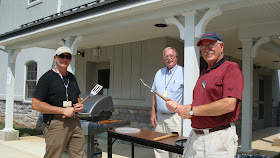

Linda S. took these pictures of the gardens at
John Brown’s House in Chambersburg earlier this month (We promise to get some pictures of the garden in season next year.) In case you were unaware, the Master Gardeners of Franklin County worked with the folks at the
Franklin County Historical Society-Kittochtinny, to establish a demonstration kitchen garden to go along with the restoration of the boarding house used in the mid 19th century. Its most famous roomer was, of course, John Brown, who planned and executed the raid at Harpers Ferry from these premises. You’ll have to take the guided tour at the house to learn about the “Bean Pole Incident” that we tried to portray with the supports you can see in the picture. If you go on certain Fridays, our leader, Linda S. will be your host guide, all gussied up in period costume, hoop dress and bonnet.
Those poles were cut from the woods behind my house, and lashed together by Donna B. using techniques described
here and
here. (I really like those 1863 hoop training tomato supports shown
here in "
The field and garden vegetables of America" book).
The garden was designed by our own Jill H. and planned with help from
Renfrew Institute's staff biologist, Dr. Doris Armstrong Goldman, the recently published author of
Moon Rue & Mary’s Root,
Plants of the Pennsylvania Dutch Four-Square Garden. The comprehensive volume covers more than 400 plants—cultivated and wild—grown and used by Pennsylvania Germans (also called Pennsylvania Dutch) in their traditional “four square” gardens.
Entries include fruits, vegetables, cooking herbs, ornamentals, and plants used for medicines, soaps, perfumes and children’s toys from around 1800 through the Civil War era. More than 100 botanical illustrations highlight the text.
Each entry in the book includes the scientific, Pennsylvania Dutch and common English names for the plant, plus geographic origin, when the plant was first used, and how it was used by the Pennsylvania Dutch and others. Tips on traditional medicinal uses, recommended historical varieties and hints for cultivation are also included. The volume is published on a CD using PDF format.
Although the privy in the picture above is for display only, and non-functional (it houses some garden tools), the archaeological excavations of the outdoor privies at Renfrew show that many of the seed varieties covered in Dr. Goldman's book were grown there.
Some of the historical vegetable seeds used at Renfrew and John Brown’s – heirloom varieties that were grown at the time - include Cardoon, Salsify, Scarlet Runner Beans, Goose Beans, Spelt Beans, and German Red Limas, hot pepper Hinkelhatz (chicken heart), as well as the variegated leafed Fish Pepper. Tomato varieties included Amish Paste, Riesentraube Cherry, Purple Calabash, and Pittman’s Plum. There were multiple cabbage varieties, as well.
Master Gardeners worked with Dr. Goldman this past Spring, starting about 600 plants for both locations at Renfrew and John Brown’s House. The Four Square Garden at Renfrew is planted entirely by school children of Franklin County. In 2009, there were over 41 classes, representing over 900 children learning both history and horticulture.
In 2010, the Four Square Garden at Renfrew will be moved to an expanded area.
You can order
Moon Rue and Mary’s Root by contacting
Renfrew Institute at:
renfrewinst@innernet.net
It’s priced at $24.00 including shipping, or $21.20, if you go there to buy it.
I'm looking forward to continued collaborative efforts with Renfrew and the Historical Society in 2010.






+5++10-14-09.JPG)
+3++10-14-09.JPG)












.jpg)

++9-1-09.JPG)

























